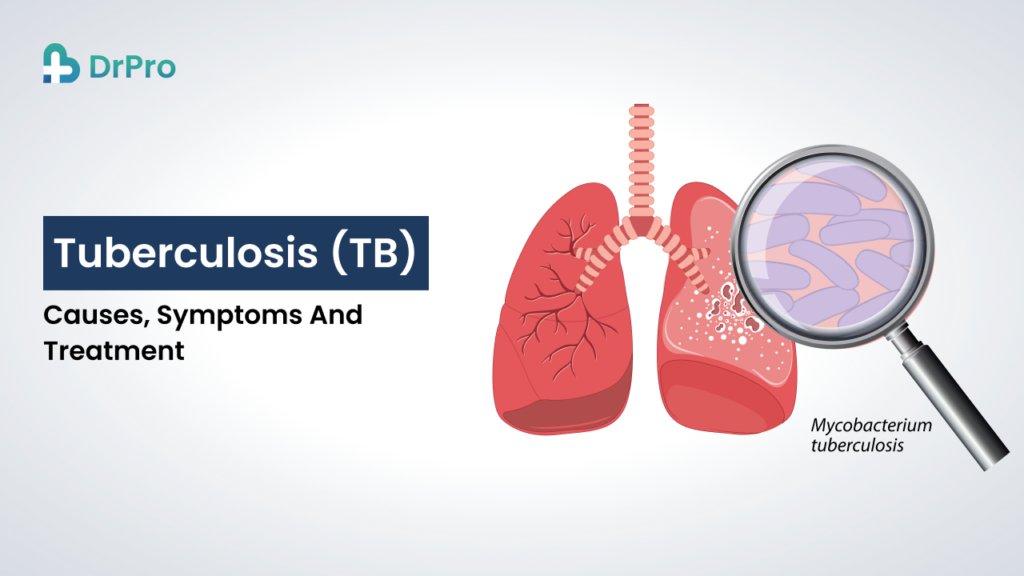Tuberculosis is severe infections that affect the lungs: it can also spread to many other parts of the body, such as the brain, kidneys, and spine. It occurs by the bacterium Mycobacterium tuberculosis. TB spreads from breathing; hence, coughing or sneezing by an infected person is highly infectious.
Despite being curable and preventable, Tuberculosis still poses a major health challenge to the world about countries. Early diagnosis and treatment are vital in curbing its spread.
This blog will provide elaborate discussions on the causes, symptoms, diagnosis, treatment, and prevention of tuberculosis.
What Causes Tuberculosis (TB)?
TB is caused by harmful bacteria, which belong to Mycobacterium tuberculosis. The airborne bacteria are released in tiny droplets through coughs, sneezes, and spits by infected individuals with active TB. If other people inhale these droplets, they are also infected.
How Does TB Spread?
TB is not spread by:
- Shaking hands
- Sharing food or drinks
- Touching surfaces
- Casual contact
But even though, it is easily contracted in crowded places where people live in close contact, such as:
- Households with sick persons
- Hospitals
- Prisons
- Shelters for the homeless
Types of Tuberculosis
Tuberculosis infections can be of two major forms:
1. Latent TB Infection (LTBI)
- The TB bacteria are present in the body and produce no symptoms.
- The individual does not experience any sickness and does not transmit TB.
- However, latent TB can progress to active TB if the immune system weakens.
- The immune system is successfully keeping the bacteria under control.
More updates for: Lung Cancer in Non-Smokers: Causes & Symptoms
2. Active TB Disease
- The TB bacteria multiply and cause symptoms.
- The individual feels sick and can transmit TB to others.
- Immediate medical attention is an absolute must.
Symptoms of Tuberculosis (TB)
Symptoms of tuberculosis (TB) vary based on which part of the body is afflicted. Tuberculosis in the lungs is generally called pulmonary tuberculosis.
Common Symptoms of Pulmonary TB:
- Persistent cough (lasting for more than three weeks)
- Coughing out blood or mucus
- Chest pain
- Shortness of breath
Other General Symptoms of TB
- Unexplained weight loss
- Fever and night sweats
- Loss of appetite
- Extreme weakness or persistent fatigue
Symptoms of TB in Other Parts of the Body:
- TB in Spine – Back pain and stiffness
- TB in Kidneys – Blood in urine
- TB in Brain (Meningitis): It has severe headaches mixed with confusion.
- TB in Lymph Nodes – Swelling in the neck
If TB is not treated in time, it may turn fatal.
Risk Factors for Tuberculosis
Such individuals at greater risk of being affected by Tuberculosis are:
1. People with Weakened Immune Systems
- HIV/AIDS patients
- Diabetes patients
- Cancer patients undergoing chemotherapy
2. People Living in Crowded Conditions
- Prisoners
- Homeless people
- Refugees
3. Malnourished Individuals
- Poor nutrition reduces immune efficiency, making the multiplication of TB easier for the bacteria.
4. People Who Smoke or Drink Excessively
- Smoking and alcohol weaken the lungs, increasing the risk of TB.
5. Healthcare Workers
- Doctors and nurses face a higher risk because they are often exposed to TB patients.
Diagnosis of Tuberculosis
Various such tests used by doctors to confirm TB include:
1. Tuberculin Skin Test (Mantoux Test)
- A small amount of TB protein (antigen) is injected into the skin.
- Build a red bump in 48-72 hours; the test is positive.
- It is not a confirmation of active TB, however; further tests are needed.
2. Blood Tests (Interferon-Gamma Release Assays – IGRA)
- They measure the immune response of the system to TB bacteria.
- This is done to test for latent TB.
3. Chest X-ray or CT Scan
- This will help the doctors check for lung damage or TB infections.
4. Sputum Test (Mucus Sample from Lungs)
Active TB is detectable in the fact that it identifies the bacteria in the mucus.
Treatment of Tuberculosis
Tuberculosis can be cured by the proper treatment. The treatment that is given most often is by taking antibiotics for six months to kill the bacteria.
1. Medications for TB
Doctors tend to prescribe 4 main TB drugs in combination depending on the needs of the patients:
- Isoniazid (INH)
- Rifampin (RIF)
- Ethambutol (EMB)
- Pyrazinamide (PZA)
2. Directly Observed Therapy (DOTS)
- Many governments are implementing the DOTS program whereby healthcare personnel ensure that patients are taking their drugs well.
- When medicines are skipped, TB may develop drug resistance that will make it more difficult to treat.
Complications of Untreated TB
If treatment for TB does not take place on time, it could lead to serious complications for health such as:
- Lung Damage-Tissue scarring becomes permanent over intact lung tissues.
- TB Meningitis– Infection goes to the brain causing inflammation.
- Bone and Joint Damage– Weakening with TB could occur to bones and joints.
- Multi-Drug Resistant TB (MDR-TB)– TB bacteria become responsive with normal antibiotics making treatment difficult.
How to Prevent Tuberculosis (TB)?
Prevention helps in controlling the spread of TB. Here is how:
1. Get Vaccinated (BCG Vaccine)
The BCG (Bacillus Calmette-Guérin) vaccine is given to infants to protect them from severe TB.
2. Take TB Medications Regularly
Latent TB patients must complete medications to avoid converting to active TB.
3. Practice Good Hygiene
- Cover one’s mouth when sneezing or coughing.
- Proper disposal of tissues to reduce the spread of bacteria.
4. Avoid Crowded Places
- The high-risk population should not contribute to places where they are overcrowded and poorly ventilated.
5. Improve Nutrition
- Nutrition completes a balanced diet which has an important contribution to an immune-boosting defense against TB.
6. Regular Health Checkups
Intervention at an early stage can help in preventing emergency complications.
Conclusion
Tuberculosis is a serious but treatable disease. The earlier the diagnosis, the greater the chance of recovery. Knowledge of the causes, symptoms, and prevention mechanisms will greatly assist in reducing the spread of TB.
If someone experiences symptoms, they should see a doctor as soon as possible. If properly cared for, TB can be controlled and eliminated.
Frequently Asked Questions (FAQs)
Q1. Is TB contagious?
Yes, active TB is contagious and can be transmitted when an infected person coughs or sneezes. Latent TB is not infectious.
Q2. How long is TB treatment?
Standard TB treatment lasts 6 months; however, some drug-resistant cases may necessitate a longer duration.
Q3. Is TB curable?
Yes; TB is normally completely curable if a responsible doctor prescribes a full course of antibiotics for the patient, who then follows it religiously.
Q4. Which food can help in TB recovery?
A high-protein diet with added fruits, vegetables, nuts, and dairy strengthens the immune system.
Q5. Who qualifies for the BCG vaccination?
The BCG vaccine is mainly given to infants in countries with high rates of TB to protect against severe forms of the disease.


